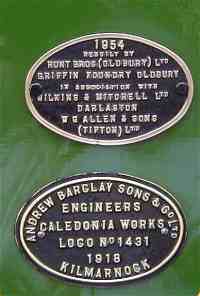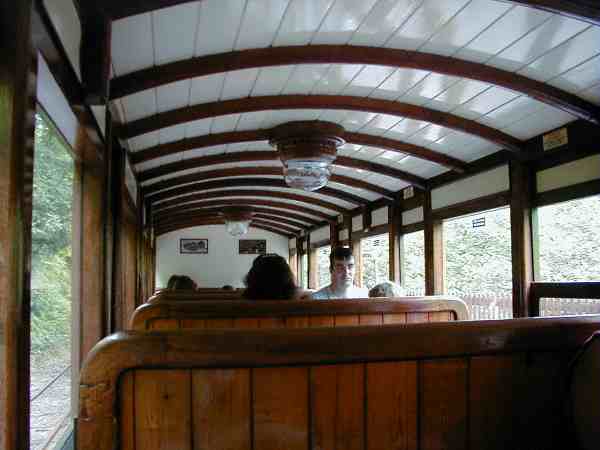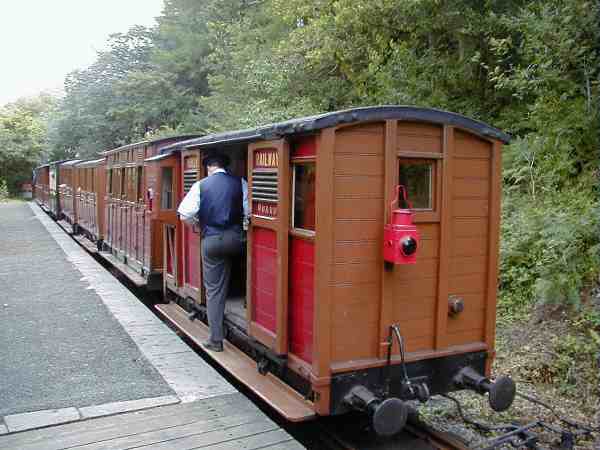Construction of the
Talyllyn Railway, between Tywyn Wharf and Abergynolwyn (6 and a half miles) started in 1864, with the first locomotives delivered late that year, originally with the sole purpose of transporting slate, for which a railway Act was not required. The cost of the civil engineering, including a viaduct and deep cuttings, prompted the owners (The McConnel family) to apply for an Act to carry passengers, as an obvious source of extra revenue. As a consequence the railway was incorporated by an Act in July 1865, by which time it's construction had already been largely completed! Subsequent inspection revealed that some bridge abutments were too narrow for coaches, rather than slate waggons, so modifications were needed (slewed rails under the bridges and fastened doors and windows on one side!) before the first passenger service could run in December 1866. Quarrying at Bryn Eglwys ceased in 1946 and there followed a run down of stocks. By 1950, with the death of it's then owner Sir Henry Haydn Jones, it looked as though this little railway had reached the end of it's line! Thanks to the untiring efforts of L.T.C. Rolt, after whom one of the locos is now named (Tom Rolt), the line was taken over in 1951 by the Talyllyn Railway Preservation Society, the first of the many to follow, such as the Festiniog shortly after.
The Talyllyn, however, was and still is unique. It was the first line in the world to be designed from it's outset as a narrow gauge steam hauled system. Some are older, such as the Festiniog, but started out as horse drawn tramways. The society had the benefit of a completely original and largely untouched (or maintained in latter years) line and rolling stock. This included two locomotives and five coaches from 1864-7 which had been in continuous use for more than 80 years. Subsequent work was to include the restoration and updating of this stock to modern safety standards and the extension of the line from the original passenger terminus on the narrow ledge above Abergynolwyn, three-quarters of a mile, to the old quarry floor at Nant Gwernol, which opened in May 1976.
My association with this railway stretches back to the birth of the society in 1951, when I was only six! I have a distinct memory of dirty, old rolling stock, rattling along, rather unsteadly on the original track. All very exciting for one so young. My visual memory has at least been refreshed by a black and white photo now in possession of my sister. The other memory I have from this trip is of the family rows created by the car used for the visit to Wales. My father had purchased a new
Morris Minor, one of the side valved, four door models launched in 1950. There is an idyllic picture of one in this advert, unfortunately reality was rather different, and we had to push this underpowered car up virtually every hill we encountered in Wales, and there is a good few! The acrimony from this ensured that my father never again wasted his money on a new car, and resulted in the purchase of a succession of second hand Fords, mainly Consuls! We were to visit it several time again, as my mother took a liking to Aberdovey, which is just 'round the corner' from Tywyn.
The present visit, was on Wednesday 4th August 1999, which as luck would have it, was mid way through the Tywyn and Talyllyn Railway's Victorian Week. Activities for the day, apart from running all their oldest Victorian rolling stock, included:
- 10-30am - 4pm, Exhibition of Victorian artifacts at the Baptist Church.
- 10am The annual outing of the Victorian School at the Baptist chapel, both staff and pupils.
- 2-3.30pm Class in the Baptist chapel visited by Queen Victoria!

We got there by the Cambrian Coaster train which passes right by the Wharf station. Like at Welshpool, we got a complimentary ticket, just in time to see the Sunday school party in a photo opportunity.

The Sunday school party in front of Douglas, the loco for the first trip of the day.


No. 6, Douglas, an 0-4-0 tank engine, one of a series built in 1918, for the Air Service Construction Corps, and in this case stationed at RAF Calshot, Southampton until 1945. Bought for resale, which did not happen, Douglas was finally presented to the society in 1953 and named after Douglas Abelson, of Abelson & Co., the donors.

Inside one of the Third class carriages.


A beautifully restored 1898 Corris Railway carriage, rescued after the closure of this line to passengers in 1930, with it's characteristic single, centre, side door. Almost completely rebuilt, after it's time as a greenhouse and garden shed at Gobowen.

No.2, One of the original 1867 Victorian coaches of the line.


No. 7, Tom Rolt, based on a 3ft. gauge loco, 1948, built for hauling turf (peat) in Ireland, bought in 1969, it was only after a lengthy and long drawn out conversion/ rebuild, that it entered service in 1991.

No. 5, the heavily restored, original 1866, Brake Van, showing it's modified 1900 form, with its brake verandah enclosed, with small projecting lookouts, with the one on the platform side having a ticket sales window.

Getting off at Dolgoch, you get this view of the viaduct over Nant Dolgoch.

The main water-fall at Dolgoch.

Map of the walks arround Dolgoch.


No. 1 Talyllyn, one of the original 1866 locos, although so restored that very little 'original' remains.

End of the day and Talyllyn is cleaned up.

















